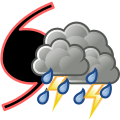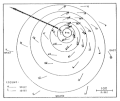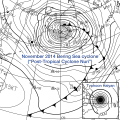Portal:Tropical cyclones
The Tropical Cyclones Portal

A tropical cyclone is a storm system characterized by a large low-pressure center, a closed low-level circulation and a spiral arrangement of numerous thunderstorms that produce strong winds and heavy rainfall. Tropical cyclones feed on the heat released when moist air rises, resulting in condensation of water vapor contained in the moist air. They are fueled by a different heat mechanism than other cyclonic windstorms such as Nor'easters, European windstorms and polar lows, leading to their classification as "warm core" storm systems. Most tropical cyclones originate in the doldrums, approximately ten degrees from the Equator.
The term "tropical" refers to both the geographic origin of these systems, which form almost exclusively in tropical regions of the globe, as well as to their formation in maritime tropical air masses. The term "cyclone" refers to such storms' cyclonic nature, with anticlockwise rotation in the Northern Hemisphere and clockwise rotation in the Southern Hemisphere. Depending on its location and intensity, a tropical cyclone may be referred to by names such as "hurricane", "typhoon", "tropical storm", "cyclonic storm", "tropical depression" or simply "cyclone".
Types of cyclone: 1. A "Typhoon" is a tropical cyclone located in the North-west Pacific Ocean which has the most cyclonic activity and storms occur year-round. 2. A "Hurricane" is also a tropical cyclone located at the North Atlantic Ocean or North-east Pacific Ocean which have an average storm activity and storms typically form between May 15 and November 30. 3. A "Cyclone" is a tropical cyclone that occurs in the South Pacific and Indian Oceans.
Selected named cyclone -
Intense Tropical Cyclone Kenneth was the strongest tropical cyclone to make landfall in Mozambique since modern records began. The cyclone also caused significant damage in the Comoro Islands and Tanzania. The fourteenth tropical storm, record-breaking tenth tropical cyclone, and ninth intense tropical cyclone of the 2018–19 South-West Indian Ocean cyclone season, Kenneth formed from a vortex that the Météo-France office on La Réunion (MFR) first mentioned on 17 April. The MFR monitored the system over the next several days, before designating it as Tropical Disturbance 14 on 21 April. The disturbance was located in a favorable environment to the north of Madagascar, which allowed it to strengthen into a tropical depression and later a tropical storm, both on the next day. The storm then began a period of rapid intensification, ultimately peaking as an intense tropical cyclone with 10-minute sustained winds of 215 km/h (134 mph) and a minimum central pressure of 934 hPa (27.58 inHg). At that time, Kenneth began to undergo an eyewall replacement cycle and weakened slightly, before making landfall later that day as an intense tropical cyclone. As a result of land interaction, Kenneth became disorganised as it made landfall and rapidly degenerated thereafter. The storm then shifted southward, with the MFR cancelling all major warnings for inland cities. Kenneth was reclassified as an overland depression after landfall, with the MFR issuing its warning at midnight UTC on 26 April. Thunderstorm activity developed off the coast of Mozambique on 27 April as the system began drifting northward. Kenneth re-emerged off the coast of northern Mozambique on 28 April, before dissipating on the next day.
In the country of Comoros; Kenneth's wind and rainfall caused at least seven deaths. Damage was estimated at US$345 million. Prior to Kenneth's landfall, local authorities evacuated over 30,000 people in the path of the storm in northern Mozambique. Kenneth killed 45 people in Mozambique. (Full article...)
Selected article -
The meteorological history of Hurricane Ivan, the longest tracked tropical cyclone of the 2004 Atlantic hurricane season, lasted from late August through late September. The hurricane developed from a tropical wave that moved off the coast of Africa on August 31. Tracking westward due to a ridge, favorable conditions allowed it to develop into Tropical Depression Nine on September 2 in the deep tropical Atlantic Ocean. The cyclone gradually intensified until September 5, when it underwent rapid deepening and reached Category 4 status on the Saffir-Simpson Hurricane Scale; at the time Ivan was the southernmost major North Atlantic hurricane on record.
Ivan quickly weakened due to dry air, but it gradually reorganized, passing just south of Grenada as a major hurricane on September 7. The hurricane attained Category 5 status in the central Caribbean Sea. Over the subsequent days its intensity fluctuated largely due to eyewall replacement cycles, and Ivan passed just south of Jamaica, the Cayman Islands, and western Cuba with winds at or slightly below Category 5 status. Turning northward and encountering unfavorable conditions, Ivan gradually weakened before making landfall just west of Gulf Shores, Alabama on September 16 with winds of 120 mph (190 km/h). The cyclone quickly weakened to tropical depression status as it turned to the northeast, and Ivan transitioned into an extratropical cyclone on September 18. (Full article...)
Selected image -

Selected season -

The 2018 Pacific hurricane season was one of the most active Pacific hurricane seasons on record, producing the highest accumulated cyclone energy value on record in the basin. The season had the fourth-highest number of named storms – 23, tied with 1982. The season also featured eight landfalls, six of which occurred in Mexico. The season officially began on May 15 in the Eastern Pacific, and on June 1 in the Central Pacific; they both ended on November 30. These dates conventionally delimit the period of each year when most tropical cyclones form in the Pacific basin. However, tropical cyclone formation is possible at any time of the year, as illustrated when the first tropical depression formed on May 10, five days prior to the official start of the season.
The second named storm of the season, Hurricane Bud, struck Baja California Sur in mid-June, causing minor damage. Tropical Storm Carlotta stalled offshore of the Mexican coastline, where it also caused minor damage. In early August, Hurricane Hector became one of the few tropical cyclones to cross into the Western Pacific from the Eastern Pacific, while also affecting Hawaii. Tropical Storm Ileana brought torrential rainfall to southwestern Mexico during early August, causing relatively minor damage. A few weeks later, Hurricane Lane obtained Category 5 intensity while also becoming Hawaii's wettest tropical cyclone on record and the second wettest tropical cyclone in United States history, only behind Hurricane Harvey of the previous year. Hurricane Olivia also struck Hawaii, resulting in relatively minor damage. (Full article...)
Related portals
Currently active tropical cyclones

Italicized basins are unofficial.
- North Atlantic (2025)
- No active systems
- West Pacific (2025)
- Remnant low Co-may (Emong)
- Severe Tropical Storm Krosa
- Tropical Depression
- Tropical Depression
- North Indian Ocean (2025)
- No active systems
- Mediterranean (2025–26)
- No active systems
- South-West Indian Ocean (2025–26)
- No active systems
- Australian region (2025–26)
- No active systems
- South Pacific (2025–26)
- No active systems
- South Atlantic (2025–26)
- No active systems
Last updated: 03:01, 2 August 2025 (UTC)
Tropical cyclone anniversaries

August 1,
- 1982 - Typhoon Bess made landfall on southern Honshu as a minimal typhoon. Rainfall from Bess caused over 1,000 landslides and killed 59 people.
- 1989 - Hurricane Chantal (pictured) makes landfall over in southern Texas at Category 1 intensity, causing $100 million in damages.

August 2,
- 1922 - A typhoon devastated Shantou in Guangdong, China, killing 50,000 people.
- 2012 - Typhoons Saola and Damrey (pictured) affect Taiwan and much of China with damages up to $700 million.

August 3,
- 1899 - The 1899 San Ciriaco hurricane develops in the central Atlantic Ocean. The cyclone will later make landfall in Puerto Rico, killing over 3,000 people and lasting for 31 days in total, becoming the longest-lived Atlantic hurricane in recorded history.
- 1988 - Hurricane Fabio (pictured) reaches Category 4 major intensity with winds of 220 km/h (140 mph) while nearing the Central Pacific basin.
Did you know…




- …that the Joint Typhoon Warning Center considers that Typhoon Vera (pictured) of 1986 is actually two distinct systems, formed from two separated low-level circulations?
- …that Cyclone Freddy (track pictured) in 2023 was the longest-lasting tropical cyclone recorded?
- …that the typhoons of 2024—Yinxing, Toraji, Usagi, and Man-yi (pictured)—made history as the first recorded instance since 1951 of four tropical cyclones coexisting in November?
- …that Hurricane Otis (pictured) in 2023 was the first Pacific hurricane to make landfall at Category 5 intensity and surpassed Hurricane Patricia as the strongest landfalling Pacific hurricane on record?
General images -

The 2015 North Indian Ocean cyclone season was a below-average tropical cyclone season which featured the highest number of deaths since the 2010 season. Despite inactivity in the Bay of Bengal caused by the ongoing El Niño, the season produced an above-average number of tropical cyclones in the Arabian Sea. The first storm of the season, Ashobaa, formed on 7 June, while the final storm of the season, Megh, ultimately dissipated on 10 November.
A total of twelve depressions were recorded, of which nine intensified into deep depressions. Of these nine, a total of four further strengthened into cyclonic storms, while two attained their peaks as extremely severe cyclonic storms. In early June, Cyclonic Storm Ashobaa produced significant flooding in eastern Oman and the United Arab Emirates. Later that month, Deep Depression ARB 02 resulted in the worst floods in the Amreli district of Gujarat in 90 years. The storm resulted in 80 deaths and an estimated 16.5 billion Indian rupees in damage in the state. In late July and early August, Cyclonic Storm Komen resulted in between 187 and 280 deaths in northeastern India, Bangladesh and Myanmar due to torrential rains as it slowly moved through the region. In early November, Extremely Severe Cyclonic Storm Chapala, the strongest storm of the season, became the first recorded tropical cyclone to produce hurricane-force winds in Yemen. During the storm's passage, areas in southern Yemen received 610 mm (24 in) of rainfall over 48 hours, or 700% of the average yearly precipitation. Just days after Chapala produced widespread damage in Yemen and the Puntland region of Somalia, Extremely Severe Cyclonic Storm Megh passed through the same region causing further destruction. Megh was judged to have been the worst tropical cyclone ever to affect the Yemeni island of Socotra, and resulted in 18 deaths on the island. The final storm of the season to form, Deep Depression BOB 03, produced significant flooding in southern India and resulted in at least 71 deaths in the region in early November. (Full article...)
Topics
Subcategories
Related WikiProjects
WikiProject Tropical cyclones is the central point of coordination for Wikipedia's coverage of tropical cyclones. Feel free to help!
WikiProject Weather is the main center point of coordination for Wikipedia's coverage of meteorology in general, and the parent project of WikiProject Tropical cyclones. Three other branches of WikiProject Weather in particular share significant overlaps with WikiProject Tropical cyclones:
- The Non-tropical storms task force coordinates most of Wikipedia's coverage on extratropical cyclones, which tropical cyclones often transition into near the end of their lifespan.
- The Floods task force takes on the scope of flooding events all over the world, with rainfall from tropical cyclones a significant factor in many of them.
- WikiProject Severe weather documents the effects of extreme weather such as tornadoes, which landfalling tropical cyclones can produce.
Things you can do
 |
Here are some tasks awaiting attention:
|
Wikimedia
The following Wikimedia Foundation sister projects provide more on this subject:
-
Commons
Free media repository -
Wikibooks
Free textbooks and manuals -
Wikidata
Free knowledge base -
Wikinews
Free-content news -
Wikiquote
Collection of quotations -
Wikisource
Free-content library -
Wikiversity
Free learning tools -
Wikivoyage
Free travel guide -
Wiktionary
Dictionary and thesaurus







































